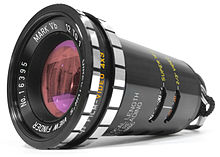Motif seeker
A motif finder is an optical device that mimics the properties of a camera .
purpose
In film productions, it is important that those responsible for creative purposes ( director , cameraman , lighting technician, etc.) know exactly the image recorded by the camera (especially the image section ). However, it would be very inefficient if the actual camera were used every time: Several people need the section, and new perspectives must occasionally be tested without moving the camera. The motif finder allows this.
Appearance
On the surface, the device looks like a lens with a rubber eyecup on the back; most have a device to wear them on a chain around the neck.
execution
In the simplest case, the motif finder consists of three lenses . Two of them produce the image on the retina that corresponds to the camera , the third is used for reversal (the image is not upside down). There is also a rectangular aperture that corresponds to the image section of the camera.
Such simple optics produce strong distortion and color deviations; but since it is primarily a matter of assessing the image detail, these are accepted.
From a visual point of view, the motif finder mimics the camera's focal length and image format. As with this, the distance between the lenses must be set according to the distance to the object ( distance setting ).
When using zoom lenses , motif finders with variable focal length are also required. It is important that the users also know the focal length set on the camera. In addition, zoom motif finders usually have several scales according to the common recording formats .
Digital motif finder
With the increasing spread of smartphones, it is possible to use specialized apps as motif finders. These apps use the phone's camera and can simulate different camera formats. One advantage over traditional motif finders is that they are much cheaper and offer the option of saving images along with metadata (e.g. GPS). Furthermore, they offer a detailed selection of camera formats, which also take the different resolutions of individual cameras into account. In theory, you can therefore achieve a higher level of accuracy than classic motif finders where, according to the manufacturer, a deviation of up to 10% is possible.
Web links
- George Leon: LOOKING THROUGH A DIRECTOR'S VIEWFINDER , A Short Story about Director's Viewfinders, English
Individual evidence
- ↑ Tech Specs . On: cadrage.at
- ↑ Mark VB Director's Viewfinder . On: alangordon.com
